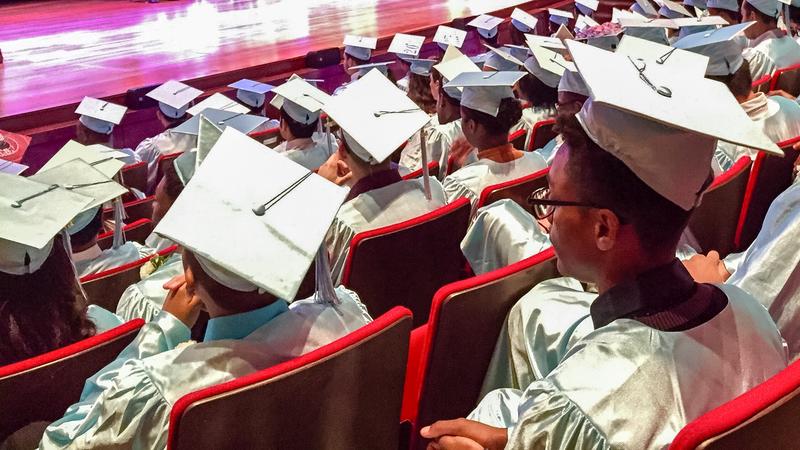
Note: The story has been updated to reflect current city numbers of classroom seats in trailers.
High school seniors have walked the aisles in their caps and gowns, and school is officially out for the rest of New York City’s public school students, faculty and staff. The 2015-16 school year featured a host of new initiatives and attempts, many of them aimed at making schools more equal in terms of course offerings and quality programs. There also were small efforts made to undo long-standing patterns of de facto segregation that have left many low-income students of color clustered in struggling schools. Here’s a review of the year that was.
Integration: Seven elementary schools won permission from Schools Chancellor Carmen Fariña to experiment with new admissions systems aimed at achieving more diversity. The schools are setting aside seats this fall for children from low-income families, as well as English language learners and kids whose parents are incarcerated.
The chancellor then announced that other school communities could apply to adopt similar policies for children at all different grade levels. Some advocates pushed for more ambition integration efforts, however, such as admissions policies for an entire local district that would assign children of different socio-economic backgrounds more evenly among the district's schools. And communities from Brooklyn Heights to the Upper West Side held contentious hearings on proposals that could improve diversity.
Meanwhile, few black and Hispanic students were offered seats in the elite specialized high schools. In response, the chancellor announced new initiatives to recruit more middle schoolers into these schools.
Renewal: This was the first full year of Mayor Bill de Blasio’s Renewal program, which was launched in late 2014 to turn around struggling schools. This year’s budget was $168 million for 94 schools; it will grow to $187.6 million next school year.
Critics, including former New York State Board of Regents Chancellor Merryl Tisch, complained that the city was throwing good money after bad. They preferred former Mayor Michael Bloomberg's strategy of closing poor-performing schools.
The city's case wasn't helped when the principal of one Renewal school, Boys and Girls High School in Bedford Stuyvesant, announced he was leaving amidst controversies and an investigation. But the Department of Education claimed it's already seeing signs of progress, including increased attendance at 83 of the 94 Renewal Schools and a 13 percent increase offers to new students at 33 of the 45 middle schools on the list.
Closures and mergers: Despite its focus on helping rather than closing struggling schools, the Department of Education did opt to close four tiny schools effective this month: FLAGS, Peace Academy Middle School, The School for the Urban Environment and Foundations Academy, which collectively enrolled fewer than 400 students.
Fariña also announced a total of 12 mergers involving 25 small schools (one merger involves three schools). With all of these restructurings, the number of renewal schools will drop from 94 to 86 in the fall.
Politics: The state legislature once again denied de Blasio a long-term renewal of his control over the city's public schools, by extending the law for just one year. Republican leaders were still angry with him for campaigning against them in 2014. This will force the mayor to seek Albany's approval next year, during his likely re-election campaign.
The State Board of Regents got a new Chancellor when Tisch's term expired. Tisch led the board during the adoption of Common Core learning standards and related new tests. Last school year, 20 percent of students opted out of their state math and reading tests and leaders of the movement spearheaded another protest this year; the state hasn't released those opt-out numbers yet. Tisch was replaced by Betty Rosa, a Regent member from the Bronx who was critical of the state's reliance on testing and said she would have opted out if she had a school age child.
Pre-Kindergarten Expansion: the de Blasio administration claimed it fulfilled its promise to provide a free, full day, high-quality pre-K seat for every four-year-old in the city. About 68,500 students were enrolled this year. However, critics have complained that not all neighborhoods are equally served.
Academics: the mayor and chancellor announced several long-term academic programs to bring computer science to more schools, early literacy interventions to elementary schools and more Advanced Placement and college-level classes for high school and middle school students.
The city cheered when the four-year on-time graduation rate crossed 70 percent.
Crowding: the city opened 10 public school buildings, however many schools remained extremely crowded, relying still on "temporary" trailers for classroom space.
The current capital plan calls for removing a total capacity of 8,000 seats from trailers. It’s about halfway there, according to the group Class Size Matters. But, the group claimed, the city has not planned enough new seats to meet growing demand.
A Department of Education spokeswoman said the actual number of students using trailer classrooms was 3,108. Of these, 681 trailer seats were removed and another 2,427 were slated for removal over the next few years.
The city also made major revisions to the way it calculates space in school buildings. The changes, reflected in the annual report known as the Blue Book, aim to offer a more accurate picture of school overcrowding.
